A content strategy encompasses the planning, creation, distribution, management, and governance of content. An effective strategy not only attracts and engages your target audience but also aligns with and advances your business objectives. It transforms what would otherwise be random acts of publishing into a highly planned system for long-term traffic growth.
An SEO content strategy, meanwhile, is your roadmap for growing an audience and generating leads by publishing, promoting, and ranking content that aligns with user intent and fulfills their expectations.
Beyond SEO considerations, a strong strategy ensures consistency. Regular posting provides fresh content for readers. It also signals to search engines that your site is active, which can improve rankings. Consistency builds credibility which helps convert readers into loyal visitors and customers.
Which types of content generate the highest website traffic?
Blog posts, step-by-step guides, listicles, and videos consistently attract strong traffic — particularly when optimized for SEO and tailored to address your audience’s specific needs. Evergreen content, which remains valuable over time, is especially effective at driving steady, long-term visitors to your site.
Creating this type of content means applying SEO best practices — both fundamental and technical — across various formats, including pillar pages, product pages, blog posts, infographics, slideshows, guides, videos, and evergreen resources.
How to Drive Traffic to Your Website with Listings
Business directories can be a valuable traffic source, but simply adding your website isn’t enough. To get noticed by local searchers, you’ll need to optimize your listings so they rank well on their platforms.
You can explore the top free business listing sites here, but your Google Business Profile is the most critical. When fully optimized, it can boost your visibility on both Google Maps and Google Search. Facebook is another key player, acting as the second-largest directory, while platforms like Yelp, Angi, and others also carry weight.
How to Develop a Content Strategy
Now that you understand why content strategy matters, let’s dive into how to craft one that truly drives traffic and conversions.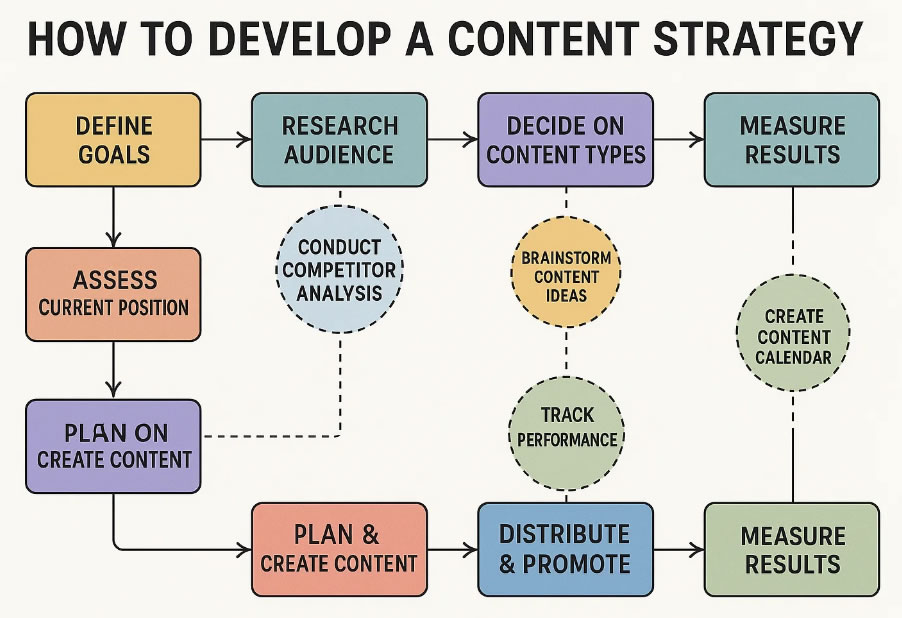
1. Set Clear Business Goals
What specific outcomes are you looking for when you create the content?
Before launching any content marketing initiative, you must establish clear business objectives and KPIs. Without defined goals, you can’t build an effective strategy, measure success, or demonstrate ROI to stakeholders.
The first step in defining your content goals is to understand what you want your content to achieve. Do you want to drive website traffic, generate leads, enhance sales, increase brand awareness, or retain customers? These different objectives require different approaches to content creation and promotion.
For instance, educational blog posts might serve to build awareness, while thorough product guides have an opportunity to convert shoppers into buyers.
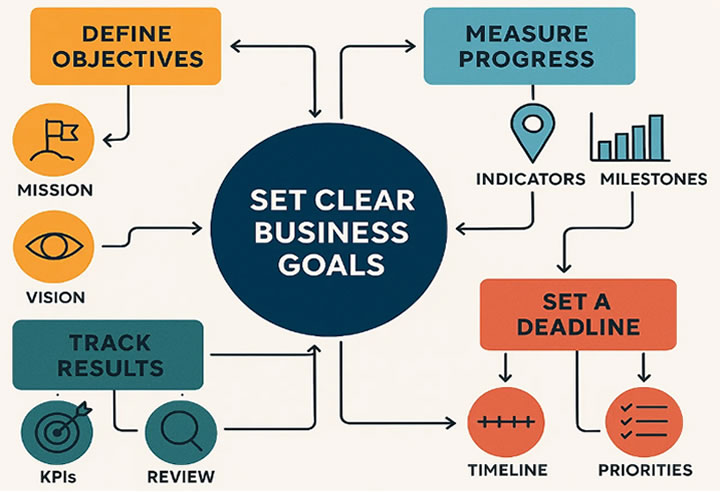
Think: increasing sales by 25% through targeted bottom-of-funnel product comparison guides or growing your email list by 35% using lead magnets like newsletters, templates for checklists.
2. Formulate a Content Roadmap
A content roadmap is an essential element of the content marketing strategy. It specifies all the content types to develop, the timing of publication, as well as how each item serves the collective and individual goals for the audience.
Identifying the playing field is the most important first step. It lays the foundation for a focused and effective content strategy. Aligning content efforts with business objectives increases the likelihood of success. It also ensures that each piece of content delivers measurable value.

A good content roadmap enables you to achieve this and gives an uncomplicated direction for efforts and makes sure that everything is aligned and consistent within the overall marketing objectives.
3. Deeply Understand Your Audience
Effective content targets the right audience. Misalignment wastes resources. Define segments carefully—whether recent grads seeking debt relief, affluent investors needing advice, or wealthy families planning estates.
Successful content strategy is what lies deep at the heart of proper audience comprehension. This is what content defines the audience by making that elegant cut between ignored content and the one that resonates and engages and drives traffic.
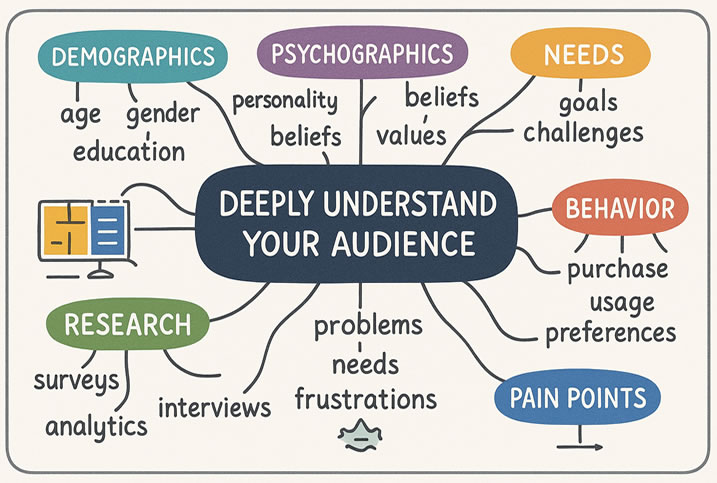
To create content that resonates, you must go beyond demographics and get laser-focused on your audience’s pain points, preferences, and content habits. Segment them by intent — like researchers (top of funnel) vs. ready-to-buy shoppers (bottom of funnel).
4. Conduct Robust Keyword and Topic Research
Keyword research underpins an SEO-focused strategy. Identify head terms and long-tail keywords aligned with search intent.
A good keyword research effort begins with brainstorming all the relevant broad topics for your business. You can utilize tools such as Google Keyword Planner, SEMrush, Ahrefs, or Ubersuggest. These platforms support more detailed and targeted keyword research. They provide insights into search volume and competition levels and also identify related keywords that may not have been previously considered.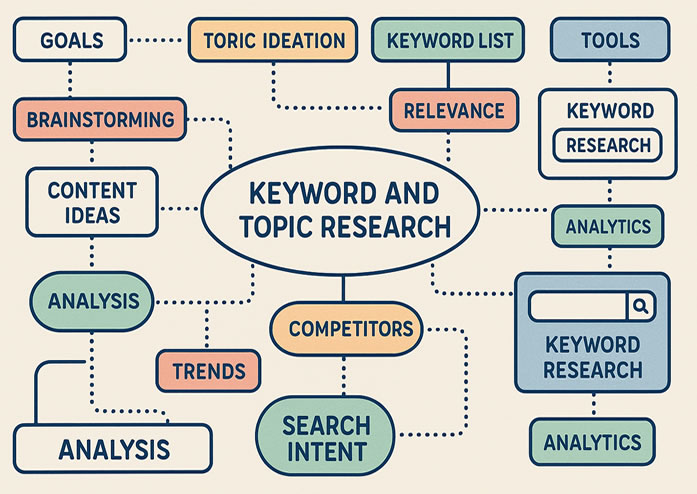
But the objective is certainly not to chase after high volumed keywords like these. Most times, long-tail keywords such as best running shoes for flat feet are more efficient than short term keywords like running shoes, because they’re more specific and generally have less competition. With long-tail keywords, more targeted guests are closer to taking action, and thus they would have a higher conversion rate.
5. Analyze Competitor Gaps and Opportunities
Competitor analysis is not about trying to replicate someone who works in the digital world; rather, it is about gathering useful information. What is beneficial to others in your niche can help you to create a better content approach which allows you to avoid certain typical pitfalls and grasp chances that others may have overlooked.
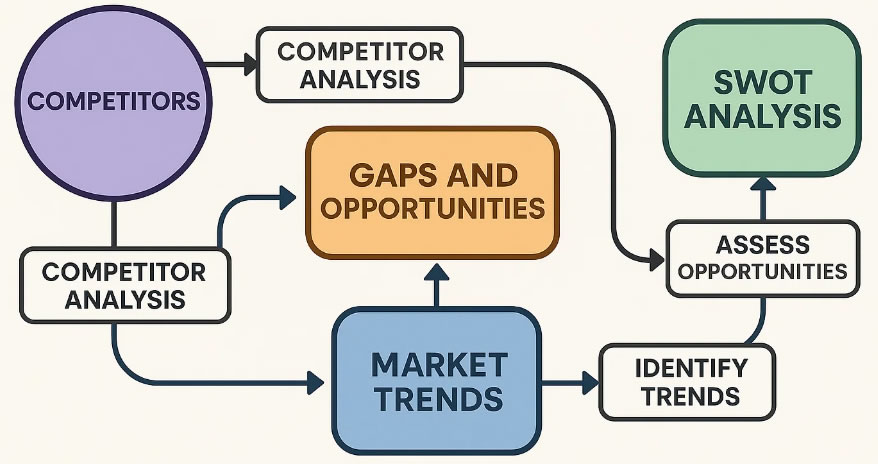
Your competitors are sitting on a goldmine of insights. Use tools like Ahrefs and Semrush to spot their top-performing keywords and content. If they dominate blogs but ignore video, seize that chance to win on YouTube or TikTok.
Competitor analysis also exposes gaps—areas in which your competitors are inadequate or topics they’ve hardly even touched upon. These gaps represent golden opportunities where you can create some exceptional content to step in and grab the limelight.
By understanding what works for others-and what doesn’t-you can develop a more effective and targeted content strategy for your brand.
6. Choose Content Formats Backed by Data
In content marketing, how a message is delivered is just as important as what is said. The right format can expand your reach and attract a diverse audience. It also increases visibility and drives traffic. People consume content in different ways. Some prefer reading blogs while others engage more with videos, podcasts, or interactive tools. A strong strategy identifies the formats that best match your audience and business goals.
Diversify your formats to cater to different learning styles:
- Written articles
- Podcasts
- Infographics
- Videos
- Webinars
- Interactive content
Analyze your audience’s preferences, then choose formats accordingly. Semrush data shows that specific content formats outperform others — test, track, and double down on what works best for your audience. Along with experimenting on various things, measure the results before fixing a content mix.
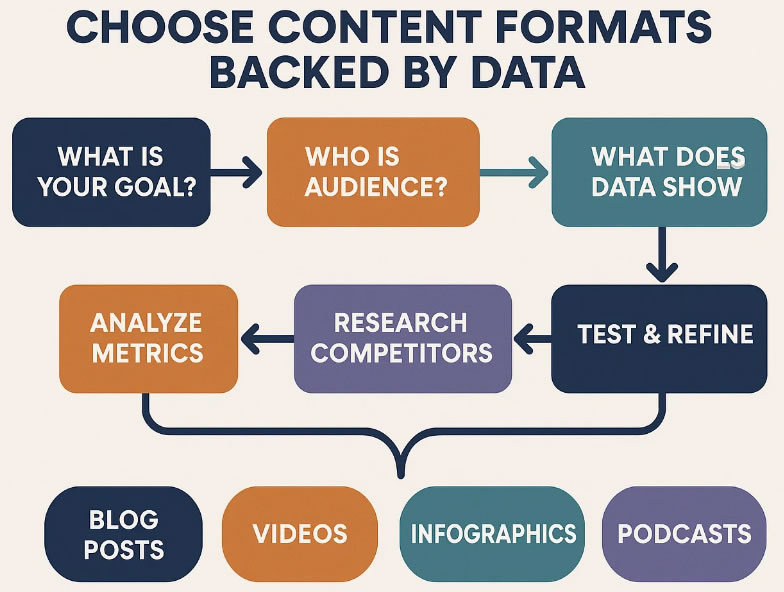
The key is not to spread yourself too thin but to focus on formats that align with your goals and audience behavior.
7. Optimize Content for SEO: On-Page and Technical Essentials
Creating valuable content is only half the effort and the other half is optimizing it to drive traffic. SEO ensures your content reaches the right audience at the right time. Optimization involves on-page and technical improvements. These steps help boost rankings, increase visibility, and support long-term traffic growth.
On-page optimization starts with keyword optimization. Each piece of content should be keenly focused around those keywords that represent what your audience is searching for. Place these keywords naturally in the title, headings (H1, H2, H3), meta description, and body text. But do not overstuff the keywords; just keep them relevant and readable.
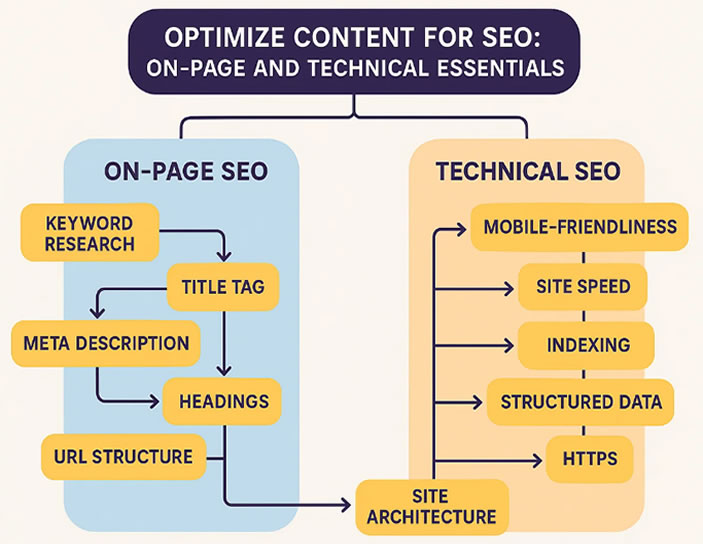
please visit also:
24 Things To Check Before Registering a Domain
Linking within your site and to outside resources plays a crucial role in strengthening your SEO.
Internal links connect pages within your website, helping users explore related content and search engines better understand your site structure.
External links, on the other hand, point to credible third-party sites, adding value for your readers and boosting your content’s authority.
8. Build a Content Calendar
A content calendar would help organize ahead of time and streamline scheduling. Define roles, timelines, and stages in the workflow. Standardize all tools across SEO, grammar check, and project management.
Content calendars are essentially a timetable of what will be published, when, and where. You’ll plan ahead of time and never feel rushed to complete new projects. It will keep your blog, social media profiles, and email campaigns running smoothly.
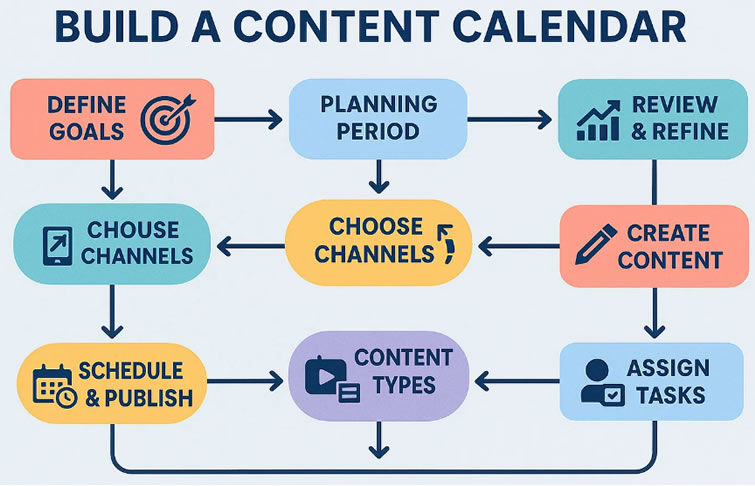
If you’re serious about success, you can’t just publish content on a whim. Create a clear, actionable plan, map it on a calendar, and execute it with precision. A well-structured calendar will ensure consistency and transparency while tracking performance. Use collaboration tools to keep everyone aligned and make the process run smoothly.
9. Distribute Where Your Audience Actually Is
Your audience isn’t everywhere — they’re concentrated in certain spaces. Your job is to meet them there.
It’s not the end of the road when publishing: there is promotion. Make amplification a process of your own:
- Rehash content over various platforms
- Blogger outreach and strategic partnerships
- Paid promotion (with clear ROI analysis)
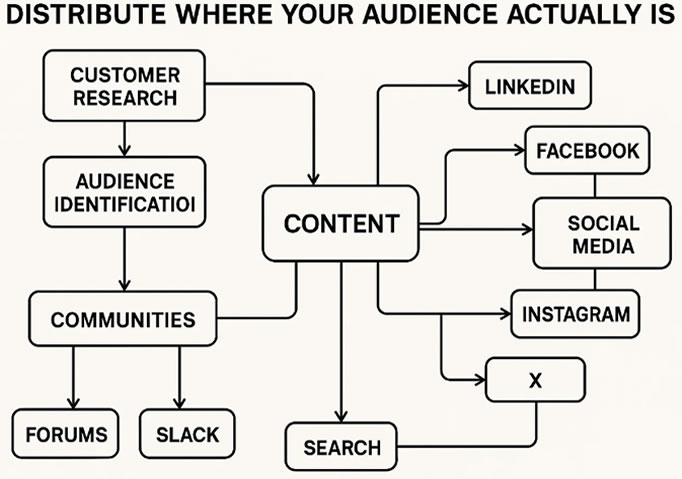
Leverage analytics to pinpoint where your content thrives and go all in on those platforms. A recent MarketingProfs study even lists the best free and paid distribution channels to get you started.
10. Use Industry Experts
Cut through the chatter by working with some thought leaders in the industry. Guest posts from respected voices lend credibility and grab new readers. Such connections will also facilitate getting features and backlinks down the line.
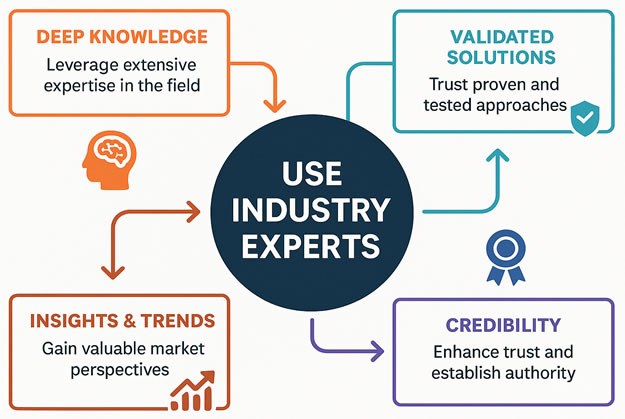
11. Keeping a Consistent Brand Voice
Trust develops through consistency. Your tone, style, and messaging should be equally applied throughout your website, blog, and social platforms. If the voice is not too approachable, let that shine, authoritative or not, on everything you publish.
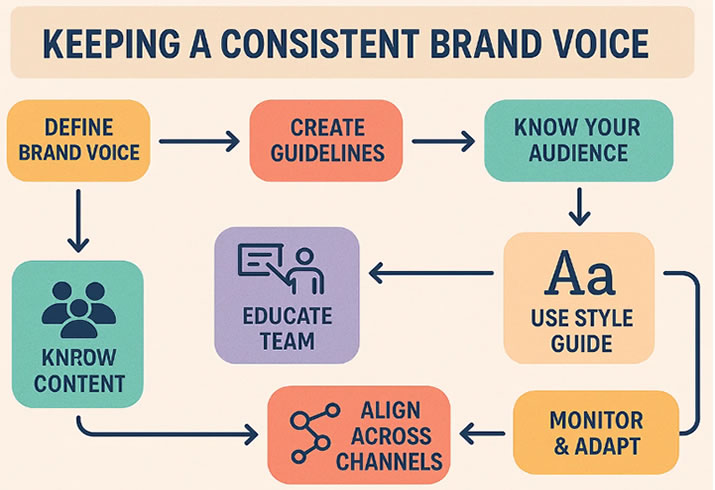
12. Make Good Use of Videos
Video content is great for engagement and makes explaining something complex easy. It can be utilized in product demonstrations, tutorials, or short educational clips. Video adds another dimension to your content and gives you the ability to reach over multiple channels.
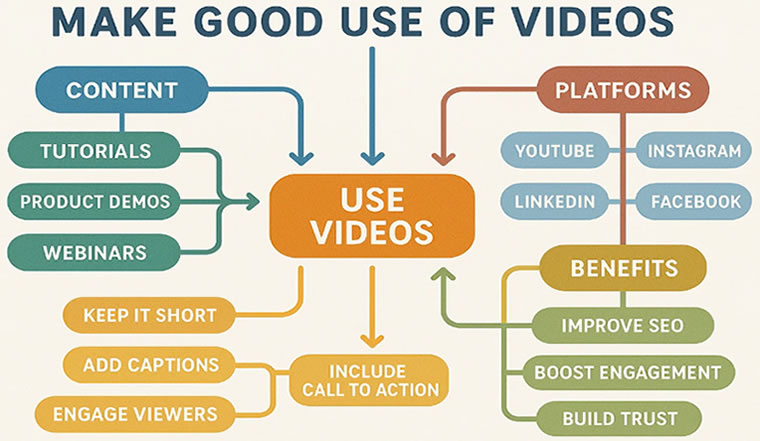
13. Authenticity Is Significant
Authenticity resonates, and thus content is created that resonates with brand values and is relatable to its audience. Transparency and consistency help cement a long-term relationship of trust and loyalty with readers. In short: authenticity isn’t just a nice-to-have; it’s a strategic advantage that shapes perception, builds community, and sustains growth.
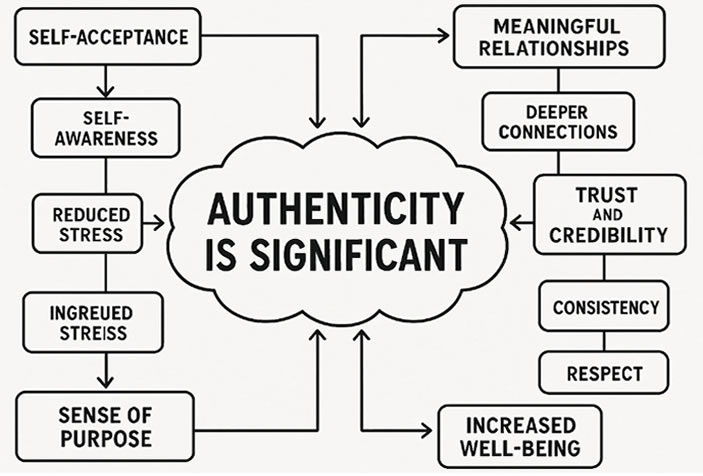
14. Licensing Top-Quality Third-Party Content
Short on time? Licensing articles from a credible third-party source can help ensure high-quality content is delivered in time. Just ensure that the sources duly engage with the interests of your readers.
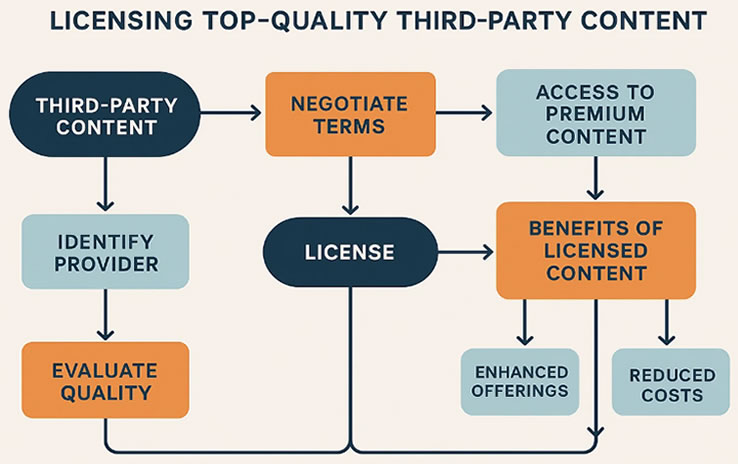
15. Curate Content Worth Reading
Curating industry news and insights will make you a valuable source of information. Google News, or Feedly, among other tools, can assist you in gathering relevant stories to keep your reader engaged and build community.
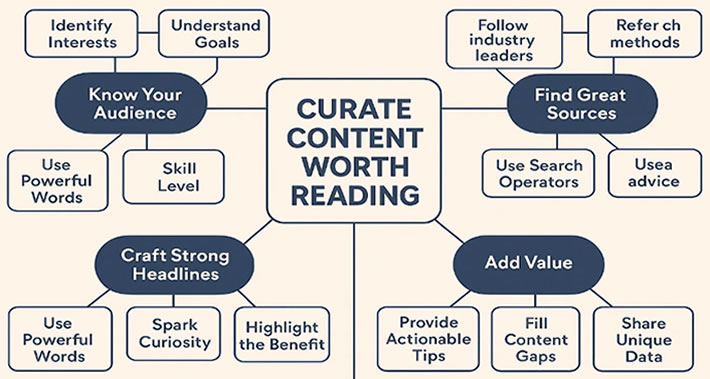
16. Keep a Balance Between the Current and the Evergreen
Current trends grab instant attention, while evergreen topics offer long-term benefits. Articles written on evergreen topics will continue drawing traffic and backlinks long after their publication. Brilliant blogs mix both types for maximum impact.
17. Write Catchy Headlines
Wired says it’s possible for a strong headline to increase traffic by 500%. Put some deeply enticing, crisp clear keyword-rich headlines together to persuade people to click it and reward your effort.
18. Partner Up with the Sales and Product Teams
Tap into the every unique insights of your sales and product teams. Their in-depth understanding of the customer pain points makes for a great enrichment of topic ideas for blog content, making sure that they are solution-focused as well as engaging.
19. Start a Business Blog
Shovel a well-structured blog into your authority earnings through lead generation from CTAs, long-term, cost-effective value over investment, and build community. HubSpot states that businesses that are serious about blogging get more than 13 times more in ROI.
20. Outsource for Consistency
Outsource to keep the content fresh for your audiences without cramping your team’s style. Quality and consistency go hand in hand and are a magic in themselves to building trust within the audience.
21. Audit and analyze your existing content
All of that and another without a strategy have built up to-it’s about time to conduct an audit of that. Anything-all: your website, social-media communications, emails, and even text characterizations. Identify high performers from the non-performers. Then check through your analytics to easily identify which type of content results in increased engagement and which does not. This is important to understand in order to revise your approach.
22. Track, Measure and Iterate Relentlessly
Once your strategy is live, don’t just sit back — monitor and refine constantly.
Performing an audit will help refine your plan by allowing you to identify areas of opportunity to improve your strategy.
Use Google Analytics, SEO reports, and engagement metrics to track performance. Watch key indicators like impressions, conversions, web traffic, time on page, clicks, and ROI.
Identify what’s winning, fix what’s underperforming, and don’t hesitate to scrap entire tactics that aren’t delivering. Iteration is the heartbeat of a content strategy that grows.
23. Choose the Best Content Management System
Decide what system will best support your workflow-whether that means a simple spreadsheet or a full-fledged CMS such as WordPress or HubSpot. In choosing tools, think about how your existing set-up fails to meet your needs and which new features (e.g.scheduling, collaboration, or analytics) will streamline your work.
24. Structured Content Architecture
After identifying your topics, the next step is to design a clear structure for your content hub and include:
Mind-map or hierarchical chart your content structure to keep things logically flowing and comprehensively covered. You will also include the key performance indicators (KPIs) you will test with later in the journey of development.
25. Create a Pillar Content Piece of Superior Quality
After the compilation of the content inventory, the process of writing the pillar content can now commence. This is supposed to be the bedrock of your content hub and should be concentrated around:
In creating the pillar content, depth, factual accuracy, and practical worth should take precedence over the heavy usage of keywords. You should aim to be the ultimate resource on the subject and provide something of real value to your audience.
26. Generate Niche Cluster Content
Cluster content exists to provide in-depth exploration into areas of interest surrounding the main topic while targeting niche keywords and addressing specific questions that audiences have. Each cluster content piece must be:
Develop a production calendar that prioritizes cluster content based on search volume and competition but also in terms of alignment with strategic business goals.
27. Create an Internal Linking System
Internal links are the stitches that sew your content hub together and help with distribution of SEO authority away from one page onto every other page in your site. Here’s how you accomplish proper internal linking:
Ideally, three to five internal links are recommended for each page, aspera virus might use such overdoing it may lead to a spammy feel or confuse the hell out of your readers.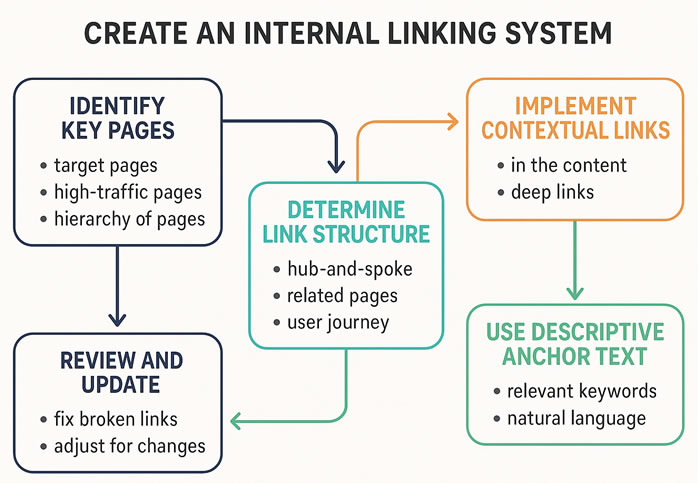
In addition to that, make sure that you go on an audit trail for broken links regularly and, when you update or refresh, ensure that you add the newer internal links.
28. Concentrate on User Experience and Interactivity
A successful content hub not only attracts visitors but also keeps them interested and facilitates deeper exploration using the following:
Engagement metrics such as time on page, pages per session, and bounce rate can directly affect your search rankings and growth in traffic.
29. Continuously Expand and Update the Hub
A content hub deserves constant upkeep to generate and enhance traffic. Here are a few things you can work on to keep your hubs on schedule: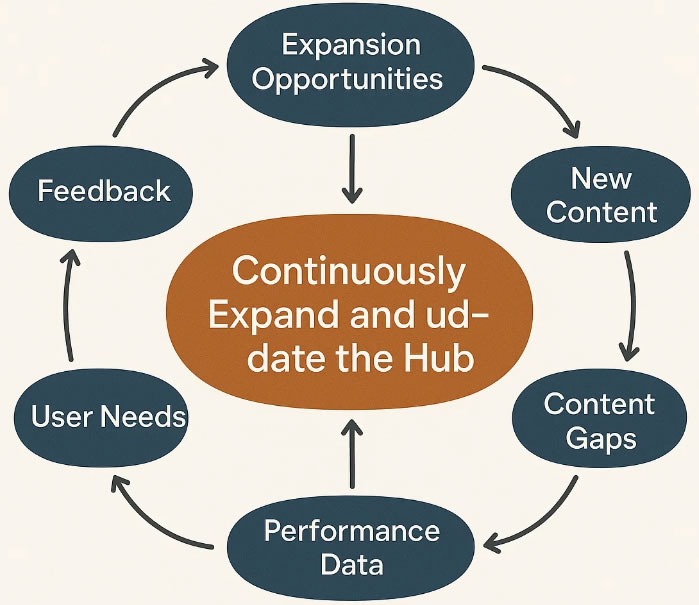
During traffic growth periods of a content hub, fresh content is likely to be added almost every month, while more significant content refreshes take place every quarter.
30. Update and Repurpose Old Content for New Traffic Gains
However, you should not overlook the strategy of refreshing and repurposing your existing content. Updating old content can save time and increase traffic. It can also improve SEO and extend the life of your content without the need to create new material. The first step is to identify outdated content that still has value. This could include articles, guides, or product reviews that no longer reflect current trends or industry standards.
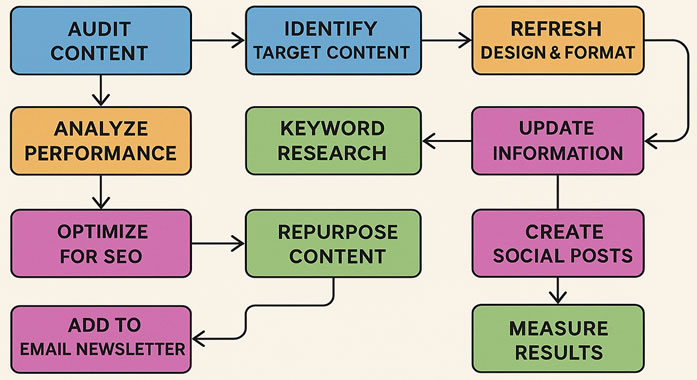
Repurposing content for other forms will help reach people who are on other platforms. A good blog could even be turned into a video, a podcast, an infographic, or even a post on a social medium. More formats help you better cover the same valuable information, presented differently, to appeal to different preferences. For example, an article could be fragmented into smaller posts or some kind of downloadable resource.
Frequently asked questions
What are the 4 key steps in a content strategy?
Effective website content planning begins with knowing your audience inside and out. From there, you will want to map out related topics that relate to their journey, produce top-tier content that lets your expertise shine, and apply analytics to fine-tune and boost your ongoing efforts.
Can you give an example of a content strategy?
An instance would be to consider taking an existing blog and enhancing its performance through SEO meanwhile improving the user experience by using smart design guiding principles and following hub-and-spoke best practices.
What are the 3 Cs of SEO?
SEO boils down to three core pillars: Content, Code, and Credibility. These essentials ensure your site stays visible and competitive.
- Content is your message and value.
- Credibility builds trust through backlinks and authority.
- Code covers the technical side—things like meta tags, canonicals, alt attributes, redirects, and a well-structured sitemap.
Why is high-quality content vital for SEO?
SEO is nothing without exceptional content. Great content solidifies trust with the users and search engines alike and, in return, trusts itself with gaining stronger rankings and more traffic toward yourself.
Why to Identify the Target Audience in SEO Content?
A clear idea of who you are targeting helps you to present content tailored to their interests and needs, making your SEO work all the more worthwhile.
What are the types of most attractive content for generating traffic?
SEO optimized blog posts, how-to articles, listicles and videos are usually placed at the forefront of attracting visitors, especially when they deal with real-life problems of their audience. It really varies based on your audience and their preferences regarding content as well as the sites they tend to favor.
Will I need to blog every single day in order to see these results?
Not at all. Daily posting isn’t necessary. What really makes the difference is consistency and relevancy. Publish either once a week or even twice but focus on the high-quality content. Most people would argue that it is at least on a weekly basis. But the simple truth is that quality should always precede quantity.
Can social networking sites take the place of content marketing for traffic?
It is a great amplifier, but it will not do anything to substitute content marketing. Rather treat them as an example of distributing and promoting your content, not as a cornerstone.
Conclusion:
A content strategy acts as a rear axle propeller for online traffic; however, implementing the entire strategy for long-term growth is the less evident part. For example, fueling the content engine by producing amazing content in large quantities, optimizing that material for search engines, and synergizing its promotion across numerous channels will attract and engage the audience indefinitely.